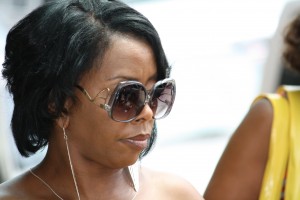 Check out this link from Nielsen to gain insight as to why a conversation with “her” is essential…and makes very good business sense…
Check out this link from Nielsen to gain insight as to why a conversation with “her” is essential…and makes very good business sense…
There is an intimacy that exists between the African-American Community and McDonald’s that is quite remarkable and noteworthy.
It is a relationship that, from a pure marketing perspective, is unprecedented and compelling.
While food is always central to the conversation, this conversation also includes community, heritage, cultural pride, accessibility, acceptance and optimism.
It isn’t captured in a commercial, though there were times when McDonald’s nailed the “essence of the special relationship” in that format.
It is an unspoken “nod” that says,
“We’re a part of your family…your community – we’ve always been in your community – and like any good friend, we’re always here for you”.
Yes, there is a special intimacy that this brand has with African-Americans (and Latinos) that is bigger than the products it sells.
Authentic is always “in”…especially in times of crisis.
From the Rodney King riots in 1992 to the upheaval and unrest in Ferguson today, McDonald’s proves that it does more than sell good food.
__________________________________________________________________________________________________
“In the wasted landscape of South Central LA, everything had been destroyed. Everything except for five buildings. In the post-apocalyptic aftermath, surrounded by smoldering ruins and debris, there were five buildings which had been untouched. Not a broken window. Not a slash of spray paint. All flooded in their usual operable fluoro lights.
These five buildings all had one thing in common. They were all McDonalds.”
‘When the smoke cleared after the mobs burned through South Central Los Angeles in April, hundreds of businesses, many of them black owned, had been destroyed. Yet not a single McDonald’s restaurant had been torched.’
Click here to read Chuck Ebeling’s full blog post, Rodney King Death Today Reminds of a Positive Lesson From LA Riots
_______________________________________________________________________________________________
“…McDonald’s, typically framed with large windows, also serves as an ideal safe zone amid heavy-handed police crackdowns, said Mitchell.
“It’s a fairly comfortable place, it’s a place they’re familiar with, lots of people go there and, in a different way, it’s a place that’s easily surveyed,” he said. “It’s a safe place, it’s so much in the public eye.”
It’s a little hard to tell whether we should be glad that McDonald’s is serving a useful public cause, or utterly depressed that traditional meeting places like libraries and local sandwich shops have been replaced by a corporate behemoths like McDonald’s and Starbucks.
(Click here to read the full HuffPost article, “How One McDonald’s Became The Epicenter Of The Ferguson Conflict“)
________________________________________________________________________________________________
In full disclosure, I am a McDonald’s supplier.
I have worked for McDonald’s local Co-Ops specializing in the areas of African-American and Ethnic Marketing. The experience has afforded me the opportunity to view the brand up close and personal for thirty uninterrupted years. At the core of what differentiates McDonald’s is the Owner/Operator – men and women who do more than sell food. In many instances, they are active and visible participants in the communities where they do business. They act as parents, advisers, counselors and active supporters of their communities.
 As a child, my mother introduced me to the music (and politics) of Nina Simone. It took me years to fully appreciate Simone’s gifts and message. A contemporary of Lorraine Hansberry, James Baldwin and Harry Belafonte, “her intelligence and restless force attracted African-American culture’s finest minds.” Simone was was one of the true pioneering voices of the Civil Rights movement. She changed the face of both music and race relations in America.
As a child, my mother introduced me to the music (and politics) of Nina Simone. It took me years to fully appreciate Simone’s gifts and message. A contemporary of Lorraine Hansberry, James Baldwin and Harry Belafonte, “her intelligence and restless force attracted African-American culture’s finest minds.” Simone was was one of the true pioneering voices of the Civil Rights movement. She changed the face of both music and race relations in America.
“Her skin was very black, and she was made fully aware of that, along with the fact that her nose was too large. The aesthetics of race—and the loathing and self-loathing inflicted on those who vary from accepted standards of beauty—is one of the most pervasive aspects of racism, yet it is not often discussed. The standards have been enforced by blacks as well as by whites.”
Click here to read the full New Yorker article, A Raised Voice, How Nina Simone Turned the Movement Into Music.
Photo: Courtesy New York Public Library
To learn more about Simone, start by reading I Put A Spell On You, The Autobiography of Nina Simone and listening to The Essential Nina Simone
Stereotypes are harmful and misleading…especially when they don’ tell the whole story.
The words of these special young people, along with those of their teacher, could go a long way to changing a situation in which the only people from outside who show up in their “fancy suits” are part of the same media that refuse to deliver the Chicago Tribune to their neighborhood.
Click here to read this seldom shown portrait of inner-city Chicago which illustrates optimism and hope despite the hardship, gloom and strife too often reported in mainstream media outlets.
There are a total of 15 charts.
I chose “Number 15″ to share, but I guarantee that the other 14 will enlighten you about two of the most vital and growing consumer groups –
African-Americans and Latinos
“No. 15 – Employers are more likely to turn away job seekers if they have African-American sounding names.”*
Click here to be enlightened.
*Source: “15 Charts that Prove We’re Far from Post-Racial,” HuffPost Black Voices, 7/2/14